November 2023 Regulatory Update
New update: Starting December 2023, we will be providing daily/weekly regulatory updates on the QIMA Blog. Stay informed about the latest regulatory news by following us on LinkedIn and subscribing to our Supply Chain Insights Newsletter.
The U.S. Consumer Product Safety Commission (CPSC) put forth a Notice of Proposed Rulemaking for a Safety Standard for Infant and Infant/Toddler Rockers (16 CFR 1240) on 26 October 2023, which was published in the Federal Register.
The proposed rulemaking includes the adoption of ASTM F3084-22 with stricter modifications to enhance safety measures and mitigate the risk of harm linked to the usage of rockers. Additionally, the commission aims to modify 16 CFR 1130, Requirements for Consumer Registration of Durable Infant or Toddler Products, to incorporate "Infant and Infant/Toddler Rockers" as part of the durable infant or toddler products category. As per 16 CFR 1130, any item deemed as a durable infant or toddler product must fulfil product registration, testing, and certification prerequisites.
View Story Read MoreThe proposed rule put forth by the U.S. Consumer Product Safety Commission for Infant and Infant/Toddler Rockers (16 CFR 1240) incorporates ASTM F3084-22 while making modifications to the standard to further reduce the risk of harm associated with the use of rockers. The aim of this proposed rule is to tackle the known dangers of infant and toddler rockers, including positional asphyxia, disassembly and collapse, hardware failures such as screws coming out and parts breaking off, and falls from elevated surfaces. The proposed rule also includes stricter labeling criteria.
The scope of this notice of proposed rulemaking includes all infant rockers and all infant/toddler rockers within the scope of ASTM F3084-22.
Products include:
- - Infant rockers, marketed for infants up to approximately six months old,
- - Infant/toddler rockers, marketed for children up to approximately 2.5 years old,
- - Combination rocker/bouncers (bouncers with curved rocker legs),
- - Combination swings/rockers (rockers that attach to a stationary swing base), and
- - Other combination products, such as rocker/bouncer/stationary chair products.
Additionally, the commission aims to modify 16 CFR 1130 to incorporate "Infant and Infant/Toddler Rockers" as part of the durable infant or toddler products category. As per 16 CFR 1130, any item deemed as a durable infant or toddler product must fulfil product registration, testing, and certification prerequisites.
Comments may be submitted to the CPSC before 26 December 2023.
On 13 October 2023, the Specification for Toy Safety, ASTM F963, was updated from the 2017 version to the 2023 version.
The revisions made to the standard affect various technical requirements for different types of toys and alignment was made to the current Federal and U.S. Consumer Product Safety Commission regulations in respect to phthalates requirements, heavy elements exemptions for toy substrate materials and tracking labels.
View Story Read MoreOn 13 October 2023, the Specification for Toy Safety, ASTM F963, was updated from the 2017 version to the 2023 version and released by ASTM International.
The revisions made to the standard affect various technical requirements for different types of toys such as:
- Sound-Producing Toys (Acoustics)
- Battery-Operated Toys (Battery Accessibility & Battery Compartment Attachment)
- Toys with Expanding Materials
- Projectile Toys (especially Toy Bows and Arrows)
Other revisions include alignment to the current Federal and U.S. Consumer Product Safety Commission (CPSC) regulations concerning phthalates requirements, heavy elements exemptions for toy substrate materials and tracking labels.
It is suggested that toy manufacturers review product lines (especially for the toy types mentioned above) to prepare for compliance with the updated Toy Safety Standard requirements.
Generally, the CPSC has 90 days to object to any revisions to the toy safety standard after receiving official notification from ASTM. If no objections are made, the revised standard is expected to become mandatory 180 days after the notification is issued.
On 27 October 2023, the California Office of Environmental Health Hazard Assessment (OEHHA) published a proposed rulemaking notification to provide an alteration to mandatory warning identification to include a specific chemical exposure to prevent indiscriminate short-form warning use.
The Proposed amendment also offers businesses a clear guidance on various facets of concise warning label criteria, including online and catalogue purchase aspects.
The period for public comments will begin on 27 October 2023 and end on 20 December 2023.
View Story Read MoreThe California Office of Environmental Health Hazard Assessment (OEHHA) has established rules relative to Proposition 65 that allow businesses to provide short-form warnings for small packages or labels to consumers about product exposures to chemicals listed as hazardous. The current short-form warnings lack a specific chemical identification requirement, leading to their excessive use as a precaution against potential legal action. Therefore, on 27 October 2023, OEHHA published a proposed rulemaking notification to provide an alteration to mandatory warning identification to include a specific chemical exposure to prevent indiscriminate short-form warning use.
These proposed modifications will be sufficient for consumers to make an informed decision about exposure to hazardous chemicals in consumer products and will comply with the “clear and reasonable” warning condition. Moreover, it will also provide businesses with precise instructions regarding other aspects of short-form warnings and safe harbor warning requirements for online and catalogue purchasers.
The period for public comments will begin on 27 October 2023 and end on 20 December 2023.
Amendments are being made to the Standard for the Flammability of Clothing Textiles, 16 CFR 1610. The revisions clarify existing provisions, expand permissible equipment and materials for testing, and update equipment requirements that are outdated.
This updated standard will become effective on 22 April 2024.
View Story Read MoreThe U.S. Consumer Product Safety Commission (CPSC) is updating the standard for the Flammability of Clothing Textiles (16 CFR 1610). Revisions to the regulation include the following:
- The clarification of the burn code for Surface Flash Base Burn (SFBB) has been provided in the regulation. The code for Surface Flash Base Burn (SFBB) is the foundational principle for classifying raised surface fabric into Class 2 and Class 3.
- The sewing thread has been updated from No. 50, white, mercerized, 100% cotton to 3-ply, white, mercerized, 100% cotton sewing thread with a Tex size of 40 ±5 Tex.
- Under the refurbishing conditions, in addition to the previous choice of perchloroethylene solvents, hydrocarbon solvents have also been added.
- The washing/drying procedure was updated to the AATCC LP1-2021. However, under 16 CFR 1610.40, the current standard of AATCC 124-2006 may still be used as an option.
The Final Rule published on 25 October 2023 adopted the proposed amendments and the updated standard will go into effect on 22 April 2024.
A reporting rule has been finalized by the U.S. EPA that necessitates industries to report any PFAS that they have manufactured or imported since 2011.
View Story Read MoreOn 28 September 2023, a final rule was released from the Environmental Protection Agency (EPA), regarding the reporting and recordkeeping requirements for per- and polyfluoroalkyl substances (PFAS) under the Toxic Substances Control Act (TSCA).
The goal of the rule is to better characterize the sources and quantities of manufactured PFAS in the United States (U.S.). The rule provides specific requirements for article importers and manufacturers in reporting of PFAS (also for PFAS-containing articles), including the type of information to be submitted and the reporting standard to be followed. The rule also includes streamlined reporting options for article importers and manufacturers of research and development substances.
According to this reporting rule, PFAS is defined as including at least one of the below three chemical structures:
- (a) R-(CF2)-CF(R′)R″, where both the CF2 and CF moieties are saturated carbons
- (b) R-CF2OCF2-R′, where R and R′ can either be F, O, or saturated carbons
- (c) CF3C(CF3)R′R″, where R′ and R″ can either be F or saturated carbons
Under such conditions, the EPA found at least 1,364 substances from the TSCA Inventory and Low-Volume Exemption claims meet this proposed structural definition. Additionally, EPA's CompTox Chemicals Dashboard identified approximately 9,400 structures that meet the proposed definition (although many of them are not known TSCA chemical substances and would be out of scope for reporting under this rule).
Regarding the reporting for PFAS manufactured or imported to the U.S., the EPA is requiring all information to be submitted electronically, via EPA's Central Data Exchange (CDX), the Agency's electronic reporting portal, to submit the necessary information (mentioned in next paragraph) under this rule.
The reporting obligation includes providing information such as the chemical identity, production volume, categories of use, byproducts, worker exposure, disposal practices, and existing information concerning environmental or health effects of the PFAS and is applicable to any PFAS that has been manufactured or imported since 2011. The reporting deadline is 18 months following the effective date* of the rule, except for small manufacturers# whose reporting deadline is 24 months following the effective date.
Note:
* The final rule will take effect on 13 November 2023.
# Refer to the definition as stated in 40 CFR § 704.3 - Definitions
In the US, when hazards are identified in consumer products, they will be recalled and published in the Consumer Product Safety Commission (CPSC) Recent Recalls on the CPSC website, which is updated daily. The US recalls from 01 October 2023 to 31 October 2023 are summarized below:
View Story Read More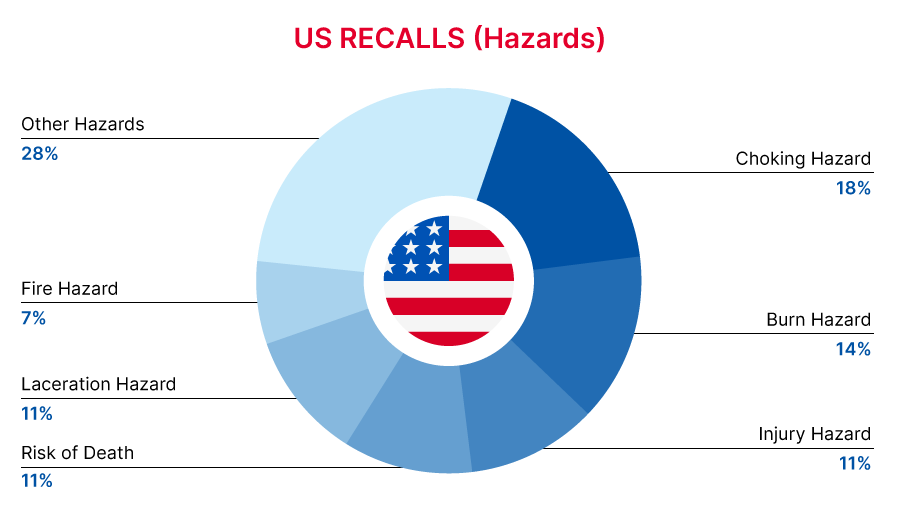
| Hazards | Frequency |
| Choking Hazard | 5 |
| Burn Hazard | 4 |
| Injury Hazard | 3 |
| Risk of Death | 3 |
| Laceration Hazard | 3 |
| Fire Hazard | 2 |
| Other Hazards* | 8 |
*Other Hazards include Entrapment Hazard, Ingestion Hazard, Eye Irritation Risk, Skin Irritation Risk, Asphyxiation Hazard, Crash Hazard, Microbiological Hazard and Fall Hazard with a frequency of less than 2.
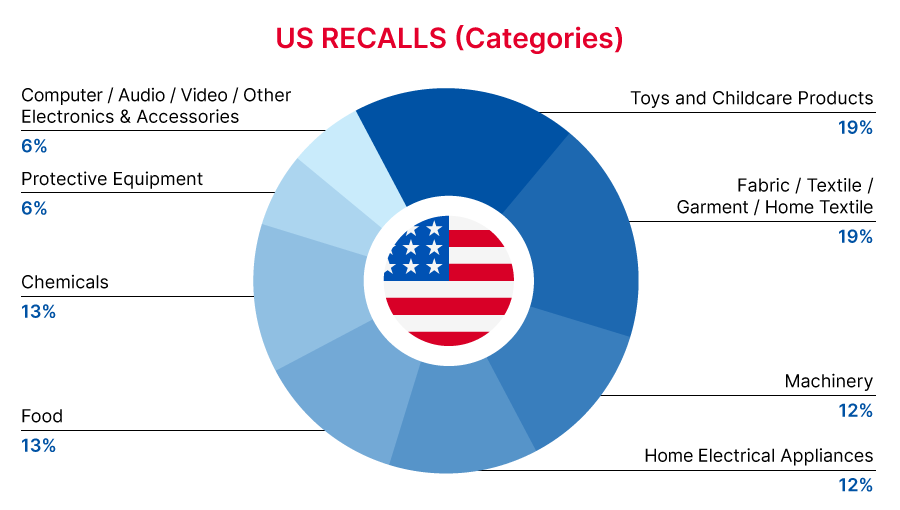
| Product Categories | Frequency |
| Toys and Childcare Products | 3 |
| Fabric / Textile / Garment / Home Textile | 3 |
| Machinery | 2 |
| Home Electrical Appliances | 2 |
| Food | 2 |
| Chemicals | 2 |
| Protective Equipment | 1 |
| Computer / Audio / Video / Other Electronics & Accessories | 1 |
For a complete list click here
In Canada, when hazards are identified in consumer products, they will be recalled and published in the Recalls and Safety Alerts Database on the Health Canada website, which is updated daily. The Canada recalls from 01 October 2023 to 31 October 2023 are summarized below:
View Story Read More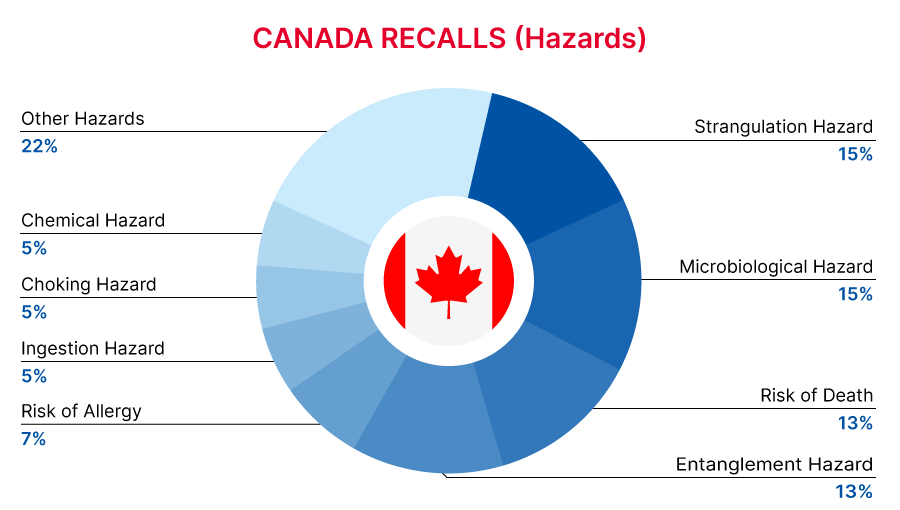
| Hazards | Frequency |
| Strangulation Hazard | 8 |
| Microbiological Hazard | 8 |
| Risk of Death | 7 |
| Entanglement Hazard | 7 |
| Risk of Allergy | 4 |
| Ingestion Hazard | 3 |
| Choking Hazard | 3 |
| Chemical Hazard | 3 |
| Other Hazards* | 12 |
*Other Hazards include Fire Hazard, Entrapment Hazard, Swallowing Risk, Safety Risk Hazard, Injury Hazard, Aspiration Hazard, Laceration Hazard, Crash Hazard and Burn Hazard with a frequency of less than 2.
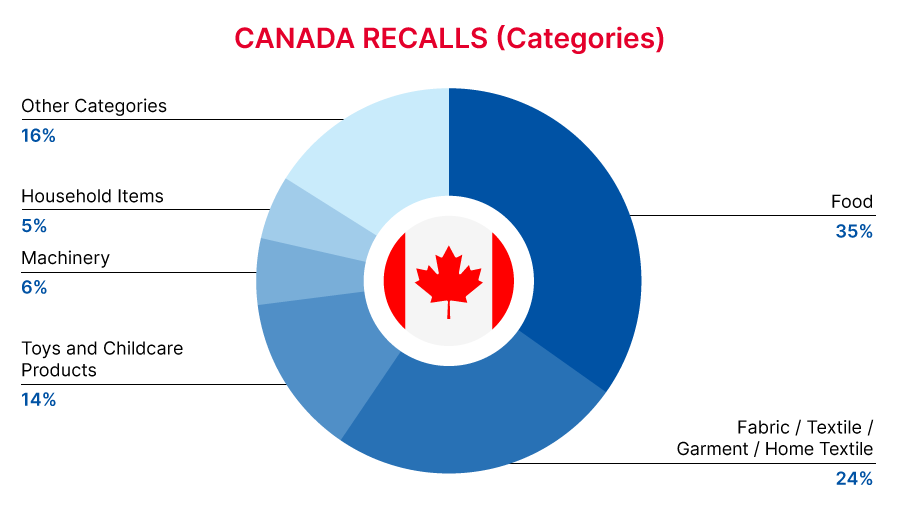
| Product Categories | Frequency |
| Food | 13 |
| Fabric / Textile / Garment / Home Textile | 9 |
| Toys and Childcare Products | 5 |
| Machinery | 2 |
| Household Items | 2 |
| Other Categories* | 6 |
*Other Categories include Protective Equipment, Cannabis, Furniture, Electrical Appliances, Home Electrical Appliances and Computer / Audio / Video / Other Electronics & Accessories with a frequency of less than 2.
For a complete list click here
In Australia, when hazards are identified in consumer products, they will be recalled and published in the Recalls and Safety Alerts Database on the Australian Competition & Consumer Commission website, which is updated daily. The Australia recalls from 01 October 2023 to 31 October 2023 are summarized below:
View Story Read More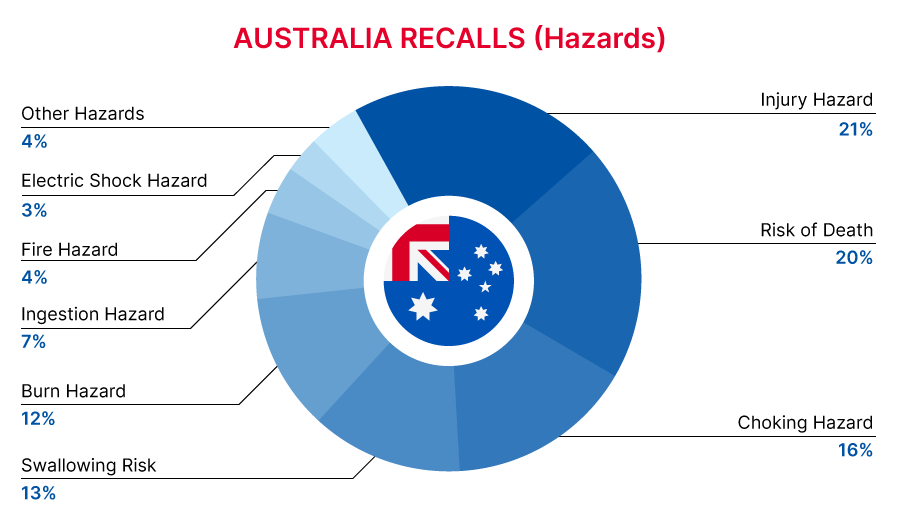
| Hazards | Frequency |
| Injury Hazard | 15 |
| Risk of Death | 14 |
| Choking Hazard | 11 |
| Swallowing Risk | 9 |
| Burn Hazard | 8 |
| Ingestion Hazard | 5 |
| Fire Hazard | 3 |
| Electric Shock Hazard | 2 |
| Other Hazards* | 3 |
*Other Hazards include Skin Irritation Risk, Risk of Allergy and Suffocation Hazard
with a frequency of less than 2.
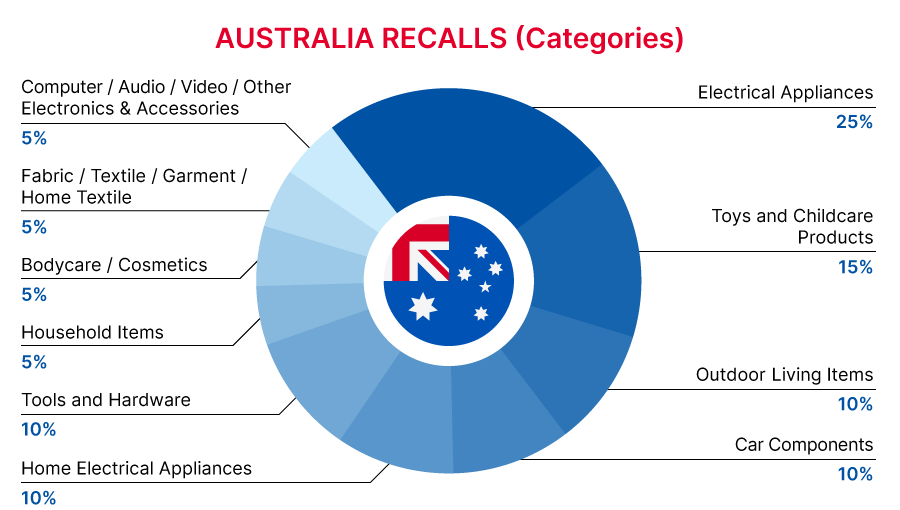
| Product Categories | Frequency |
| Electrical Appliances | 5 |
| Toys and Childcare Products | 3 |
| Outdoor Living Items | 2 |
| Car Components | 2 |
| Home Electrical Appliances | 2 |
| Tools and Hardware | 2 |
| Household Items | 1 |
| Bodycare / Cosmetics | 1 |
| Fabric / Textile / Garment / Home Textile | 1 |
| Computer / Audio / Video / Other Electronics & Accessories | 1 |
For a complete list click here
In Europe, when hazards are identified in non-food consumer products, the products will be recalled and published in the Safety Gate system, which is updated weekly. The European recalls from 01 October 2023 to 31 October 2023 are summarized below:
View Story Read More
| Hazards | Frequency |
| Chemical Hazard | 168 |
| Environmental Hazard | 39 |
| Injury Hazard | 35 |
| Choking Hazard | 32 |
| Electric Shock Hazard | 24 |
| Strangulation Hazard | 10 |
| Burn Hazard | 4 |
| Other Hazards* | 16 |
*Other Hazards include Damage to Sight, Fire Hazard, Health Risk Hazard, Cut Hazard, Risk of Death, Asphyxiation Hazard and Suffocation Hazard with a frequency of less than 4.

| Product Categories | Frequency |
| Bodycare / Cosmetics | 112 |
| Toys and Childcare Products | 60 |
| Electrical Appliances | 45 |
| Chemicals | 15 |
| Machinery | 13 |
| Fabric / Textile / Garment / Home Textile | 11 |
| Jewelry | 10 |
| Other Categories* | 33 |
*Other Categories include Computer / Audio / Video / Other Electronics & Accessories, Construction Products, Accessories, Tools and Hardware, Protective Equipment, Sporting Goods / Equipment, Home Electrical Appliances, Car Components, Footwear, Household Items and Outdoor Living Items with a frequency of less than 10.

| Notifying Country | Frequency |
| Hungary | 57 |
| Sweden | 53 |
| Italy | 52 |
| France | 25 |
| Lithuania | 19 |
| Germany | 13 |
| Finland | 13 |
| Poland | 10 |
| Ireland | 9 |
| Romania | 9 |
| Other Countries* | 39 |
*Other Countries include Slovakia, Czechia, The Netherlands, Denmark, Slovenia, Estonia, Bulgaria, Malta, Cyprus, Croatia, Latvia, Austria and Luxembourg with a frequency of less than 7.
For a complete list click here
The National Health Commission of China published Notice No. 6, 2023 to approve 85 national standards; among these standards, there are 17 standards for food contact materials.
View Story Read MoreIn September 2023, The National Health Commission (NHC) of China published Notice No.6 of 2023 to announce 85 national standards. Included in these standards, are 17 standards for food contact materials.
Updated and new standards for food contact materials are as follows:

In China, when hazards are identified in consumer products, they will be recalled and published in the SAMR Defective Product Administrative Centre, which is updated daily. The China recalls from 01 October 2023 to 31 October 2023 are summarized below:
View Story Read More
| Hazards | Frequency |
| Fire Hazard | 23 |
| Safety Risk Hazard | 21 |
| Electric Shock Hazard | 16 |
| Health Risk Hazard | 11 |
| Injury Hazard | 8 |
| Entanglement Hazard | 7 |
| Fall Hazard | 6 |
| Crash Hazard | 6 |
| Other Hazards* | 16 |
*Other Hazards include Skin Irritation Risk, Risk of Allergy, Suffocation Hazard, Microbiological Hazard, Chemical Hazard, Burn Hazard, Explosion Hazard, Choking Hazard and Cut Hazard with a frequency of less than 4.

| Product Categories | Frequency |
| Fabric / Textile / Garment / Home Textile | 14 |
| Sporting Goods / Equipment | 12 |
| Electrical Appliances | 11 |
| Home Electrical Appliances | 8 |
| Protective Equipment | 2 |
| Chemicals | 2 |
| Toys and Childcare Products | 1 |
| Household Items | 1 |
| Stationery | 1 |

| Provinces | Frequency |
| Guangdong | 14 |
| Hunan | 12 |
| Jiangsu | 7 |
| Sichuan | 7 |
| Beijing | 4 |
| Henan | 3 |
| Chongqing | 2 |
| Shandong | 1 |
| Jilin | 1 |
| Shanghai | 1 |
For a complete list click here

